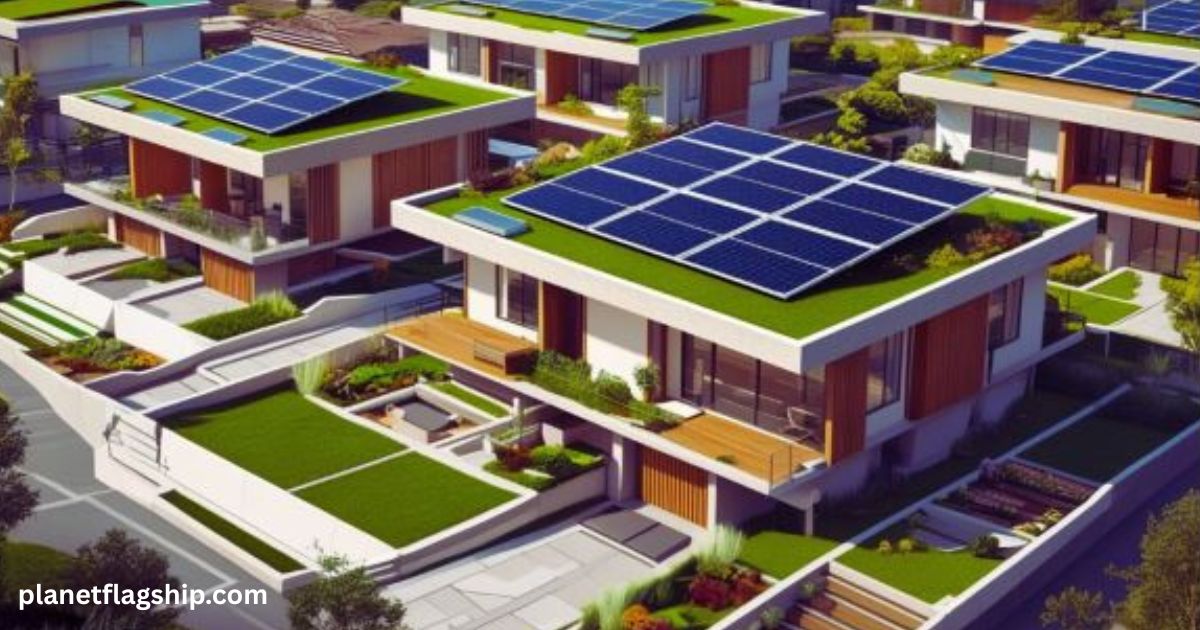Climate resilient housing are supposed to be safe havens. However, in various parts of Pakistan and the Global South, homes are far from safe during climate-related events. In 2022, Pakistan experienced catastrophic floods that affected over 33 million people, destroying well over 2 million homes (World Bank, 2023). Many of these houses were poorly built, made from mud or unreinforced materials, offering little resistance to rising waters.
Similarly, in India, Bangladesh, parts of Africa, and Southeast Asia, informal housing in urban slums and rural areas often lacks the infrastructure to handle extreme heat or flooding (UN-Habitat, 2022). These homes trap heat, flood easily, and offer little to no protection during storms or heat waves.
Climate change has exposed deep inequalities in housing. Those who are already struggling low-income families, the elderly, the disabled, and the displaced are the ones most at risk.
Climate change is no longer a distant possibility; it is happening right now, and it is reshaping how we live, particularly in terms of how we build and protect our homes. As rising temperatures, floods, droughts, and storms become more frequent, countries like Pakistan are at the forefront of this global crisis. Housing, once a static structure meant to provide shelter, is now a vital component in the fight for survival and stability.
For millions, especially in developing countries, climate-resilient housing is no longer a luxury; it is a necessity.
A climate resilient housing can withstand extreme weather events while ensuring the safety, comfort, and well-being of its residents. It must have a functional structure, a safe location, reliable materials, efficient energy use, and healthy social systems surrounding it.
Designing for Resilience: Innovations That Are Already in Practice

1. Elevated and Flood-Proof Structures
Architects in the Netherlands are already designing homes on stilts or floating foundations, targeting areas prone to flooding. Architects in the Netherlands are building their neighborhoods on buoyant platforms that fluctuate in response to water levels (Gould, 2022). Materials used in such homes have functional tendencies, such as waterproof concrete and water-resistant insulation, which are essential in preventing long-term damage.
2. Fire-Resistant Construction
Wildfires have destroyed thousands of homes in California over the past few years. Fire-resistant materials, such as metal roofing, concrete siding, and ember-resistant vents, are being used to prevent damage. Landscaping is also critical; clearing vegetation, creating defensible space, and using gravel instead of mulch can slow the spread of flames (Cal Fire, 2023)
3. Passive Cooling and Energy Efficiency
Architects are increasingly turning to passive design techniques, such as orienting homes to take advantage of natural shade, installing reflective roofs, and utilizing cross-ventilation to cool interiors without the need for air conditioning (UN-Habitat, 2021). Thick walls, green roofs, and window shutters also reduce indoor heat.
4. Renewable Power and Off-Grid Capabilities
New houses are being built with solar panels and battery storage, allowing families to remain powered even during outages (World Bank, 2022). Similar off-grid solutions are emerging in rural Africa, where solar-powered homes with rainwater harvesting systems and composting toilets are transforming lives.
5. India’s Climate-Smart Villages
In Bihar and Assam, architects are collaborating with communities to construct stilted homes using bamboo and brick, designed to withstand floods and provide airflow during heat waves. These homes often include rooftop rainwater collection and cool roofs (Singh & Kumar, 2022).
READ MORE: Sustainable Finance Revolution: How Ethical Banking is Saving Our Planet
Resilience Through Policy and Planning
To build the future of climate-resilient housing, governments must step in with supportive policies and funding.
1. Updating Building Codes
Outdated building codes put lives at risk. Pakistan’s current urban planning and construction standards often fail to account for modern climate realities. Codes need to require flood-resistant foundations, insulation for heat, and water conservation systems (Nasir et al., 2020).
2. Incentives for Green Construction
Governments can encourage homeowners and builders to adopt resilient designs by offering subsidies or tax breaks for solar panels, green roofs, or water-saving technologies.
3. Protecting Informal Settlements
In informal settlements, the majority of Pakistan’s urban poor reside without permits or access to basic infrastructure. Relocating these communities is not always feasible or fair. Instead, “in situ upgrades,” where homes are improved in place, should be prioritized. This approach respects people’s social ties and livelihoods while improving safety.
The Role of Technology and Innovation

Emerging technologies are playing an increasing role in building climate-resilient homes.
- 3D Printing: Researchers are testing 3D-printed homes in locations such as Mexico and India to create quick, affordable, and climate-resilient shelters.
- Climate Modeling Tools: Data-driven tools help identify high-risk areas, allowing new housing to be in safer zones.
- Mobile Apps: Some NGOs have developed mobile platforms that educate homeowners about climate-resilient techniques or enable them to report damage during disasters.
Digital tools combined with local wisdom could be game changers in shaping the future of housing.
New materials are transforming what homes can endure. From self-healing concrete that repairs its cracks to phase-change insulation that stores and releases heat based on the day’s temperature, the science of building is evolving rapidly (RILEM, 2022).
3D-printed homes, already in use in Mexico and the U.S., offer an affordable way to build climate-resistant structures quickly. Many are made from sustainable materials and withstand both floods and earthquakes.
Meanwhile, smart home systems now alert homeowners to risks like rising water levels, air quality hazards, or power surges, which allows for quicker responses and potentially life-saving decisions.
Climate Resilient Housing Is About Equity
At its core, building climate-resilient homes is not just about materials and architecture. It is about justice and human rights.
Every person deserves a safe place to live, regardless of their income or location. By prioritizing resilient housing, we are preparing for floods or heatwaves and investing in human dignity, health, and the ability to thrive.
For Pakistan and many other vulnerable countries, this is a moral and economic imperative. The cost of inaction, in terms of both human lives and financial damage, is far greater than the cost of building safe, sustainable homes now.
Community Involvement: The Key to Long-Term Success
Technology and policy are vital, but without community engagement, they often cannot deliver their full potential. Resilience is not just about physical structures; it is about people.
When communities are involved in the design, construction, and maintenance of their homes, they are more likely to adopt and sustain climate-resilient practices. In many rural Pakistani villages, women are leading the charge in managing solar energy, teaching others about climate risks, and deciding about local building priorities (Shah, 2022).
Grassroots-led solutions are often more culturally appropriate, cost-effective, and sustainable in the long run.
FAQ’s
What is a climate-resilient home?
A climate-resilient home is designed to withstand extreme weather like floods, heatwaves, and storms. These homes use durable materials, smart design, and renewable energy to keep families safe while reducing environmental impact.
Why are climate-resilient homes important in countries like Pakistan?
In places like Pakistan, millions live in flood-prone or heat-vulnerable areas. Climate-resilient housing reduces disaster risks, saves lives, and protects livelihoods. For vulnerable communities, it’s not a luxury—it’s a necessity for survival.
What materials are best for building climate-resilient houses?
Materials such as waterproof concrete, bamboo, fire-resistant metal roofing, and locally sourced sustainable bricks are widely used. Green roofs, reflective paints, and insulation also make homes cooler, safer, and more energy efficient.
How can governments support climate-resilient housing?
Governments can update building codes, offer subsidies for green construction, and protect informal settlements through in-place upgrades. By investing in climate-ready housing, they reduce long-term economic and social costs.
How can communities contribute to building climate-resilient homes?
Communities play a key role by sharing local knowledge, participating in design, and maintaining structures. Grassroots efforts like women-led solar energy projects in rural villages prove that resilience grows stronger when people are directly involved.
Conclusion: Building the Future, One Home at a Time
The homes of the future will not only shelter us but also protect us from the planet’s growing extremes. For Pakistan and other climate-vulnerable countries, the future of housing must be built on resilience, inclusion, and smart planning.
With government support, community leadership, and a focus on equity, we can ensure that homes are no longer the weakest link in climate response but one of our greatest strengths.
The storm is approaching, but armed with the appropriate tools, knowledge, and compassion, we can navigate it together.
References
Aga Khan Agency for Habitat. (2021). Community-based climate-resilient housing in Pakistan. https://www.akdn.org
City of Rotterdam. (2022). Water plazas contribute to the resilience of urban floods. https://www.rotterdam.nl
Nasir, M., Ali, S., & Zafar, F. (2020). Urban infrastructure, governance, and climate resilience in Pakistan. Sustainable Cities and Society, 52, 101870. https://doi.org/10.1016/j.scs.2020.101870
Shah, S. A. (2022). Women’s role in community-led climate resilience in Pakistan. Journal of Climate and Development, 14(3), 205–218.
Singh, R., & Kumar, V. (2022). Designing flood-resilient homes in India: A local approach. Habitat International, 118, 102503. https://doi.org/10.1016/j.habitatint.2021.102503
UNDP. (2021). The project involves the construction of floating homes in Vietnam as a means of adapting to floods. United Nations Development Programme. https://www.undp.org
UN-Habitat. (2022). Affordable and resilient housing for all. https://unhabitat.org
World Bank. (2023). Pakistan Floods 2022: Post-disaster needs assessment. https://www.worldbank.org
Australian Building Codes Board. (2022). National construction code: Bushfire provisions. https://www.abcb.gov.au
Build Change. (2023). Safer homes, stronger communities. https://buildchange.org/
Cal Fire. (2023). Preparing homes for wildfire. California Department of Forestry and Fire Protection. https://www.fire.ca.gov/programs/communications/defensible-space/
Federal Emergency Management Agency. (2021). Building codes save: A nationwide study. https://www.fema.gov/sites/default/files/documents/fema_building-codes-save-study_2020.pdf
Gould, K. A. (2022). Floating homes in the Netherlands: An innovative solution for sea-level rise. Journal of Urban Planning and Development, 148(1), 04021070. https://doi.org/10.1061/(ASCE)UP.1943-5444.0000697
RILEM. (2022). Innovations in construction materials for climate resilience. International Union of Laboratories and Experts in Construction Materials, Systems and Structures. https://www.rilem.net/
UN-Habitat. (2021). Green building design for climate-resilient cities. https://unhabitat.org/
World Bank. (2022). Resilient infrastructure for a changing climate. https://www.worldbank.org/en/topic/climatechange/public

John is a professional blogger and passionate advocate for environmental sustainability. With years of experience exploring eco-friendly practices and green innovations, he shares insightful articles on Planet Flagship to inspire a sustainable future. John’s expertise lies in making complex environmental topics accessible and actionable, empowering readers to make meaningful changes for the planet.
